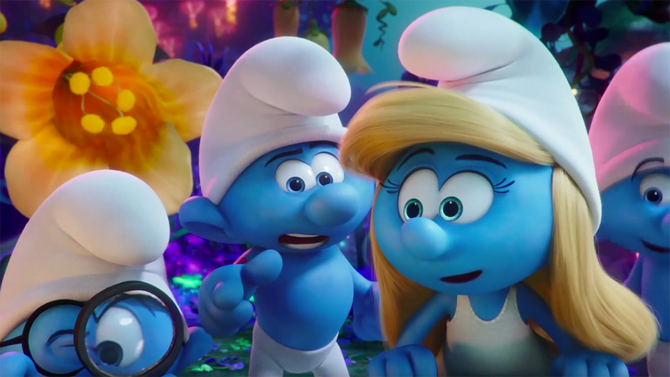Contents
 It takes a village of Smurfs to add up to one personality, but in their third film the blue mascots of cute wisely shed live action.
It takes a village of Smurfs to add up to one personality, but in their third film the blue mascots of cute wisely shed live action.
If you go with your family to see “Smurfs: The Lost Village” (and let’s be honest: most of today’s animated features are more than suitable for adults only, but anyone who would go to this movie without children is seriously starved for entertainment), you’ll get to experience the trailer for “The Emoji Movie,” an upcoming feature from the same studio, Sony Pictures Animation. The trailer is hosted by an emoji named Meh, voiced in the morose observational tones of comedian Steven Wright; in just 30 seconds, he makes not being overly enthusiastic about anything seem the apex of hilarity. I won’t prejudge the film, but it’s a stupendous trailer.
Then we get to the Smurfs movie, which has a hundred characters who are Smurfs, and not one of them is as funny, or wry, or distinctive as Meh. You might describe the Smurfs as blueberry Hobbits crossed with knockoffs of the Seven Dwarfs — or, more precisely, of Dopey, since they mirror his innocent leer of a grin, open-car-door ears, and hat that’s like a folded-over blob of Poppin’ Fresh dough. (I do realize that the Smurfs were created in Belgium in 1958, and that their headwear was meant to evoke the Phrygian cap, which signifies freedom. But they still look like Dopey.) As with the Dwarfs, the Smurfs have names that describe just what they are: in this case, Jokey, Nerdy, Grouchy, Brainy, Clumsy, Nosy, Hefty, Winner, Loser, Painter, Scuba, Paranoid, Therapist (“Sometimes,” says a patient, “I just feel blue!”), and Table-Eater. Unlike the Seven Dwarfs, the Smurfs, even with their Defining Traits, seem to have more or less interchangeable personalities. They’re one-note elfin mascots of cute who are all, in essence, variations on the same product.
Last November, when “Trolls” came out, a number of critics described it as being sort of like a Smurfs movie. Well, it kind of was — but if so, it was the “Citizen Kane” of Smurf movies, a kaleidoscopic disco fantasia with marvelously individualized troll-doll characters. (I’ve seen it three times and could easily watch it again.) “Smurfs: The Lost Village,” by contrast, is a sweetly benign fantasy for three-to-seven-year-olds, and though one should show no hesitation in calling it innocuous, because it is, I do realize that’s all part of the design. It’s not a rousing animated comedy that parents will cherish along with their kids. It’s more like a colorful and diverting pacifier.
Yet it has one major advantage over its two big-screen predecessors, “The Smurfs” (2011) and “The Smurfs 2” (2013). (There was also a Smurfs cartoon, “The Smurfs and the Magic Flute,” back in 1983.) Both those movies placed animated Smurfs in a live-action universe, and both had the painfully shrill, bonk-you-over-the-head tone that can turn actors as gifted as Neil Patrick Harris and Hank Azaria into blaring annoyances. “The Lost Village” ditches all that. It’s a pure digital fantasy, with elegant and tactile animation, so it’s more true to the Smurf spirit, and should perform solidly.
In the Smurf village, that land of colorful mushroom huts, every character is male except for Smurfette (voiced by Demi Lovato), who has a rounder face than that of the boy Smurfs, and who looks like she stole Nancy Sinatra’s hair. So much for her personality. Smurfette, as fans of the Smurfs franchise know, was created by the evil wizard Gargamel out of a lump of coal, which is one reason that she doesn’t feel quite at home. Gargamel is voiced, by Rainn Wilson, in one of those fluttery aristocratic accents descended from effete Hollywood villains of the ’40s, and he’s animated in a way that sticks true to the original Peyo cartoon: With his lone tooth, bald fringe, and dark robe, he looks like a Trappist monk drawn by Hanna-Barbera.
Gargamel plans to round up all the Smurfs, so that he can pour them into a boiling-cauldron potion that will render him all-powerful. And there you have the plot. The valiant Smurfette frees a trio of Smurfs — Clumsy, Brainy, and Hefty — from Gargamel’s clutches, and once they escape the movie turns into an elongated if rather rudderless chase that takes our heroes (and heroine) through the Forbidden Forest, through white-water rapids (the most visually enticing sequence), and into a garden of fire-breathing dragonflies and flowers that will eat you.
As it turns out, the Smurf village isn’t the Lost Village. That would be Smurfy Grove, an all-girl Smurf enclave presided over by Smurfwillow, voiced by Julia Roberts with an incongruous maternal snap. (She has the kind of personal punch the rest of the movie barely hints at.) There is also a tear-jerking twist that really works, though it’s a bit manipulative to see in a movie aimed at kids this young. Imagine that Bambi’s mother had died, and then come back to life as the star of her own franchise. “Smurfs: The Lost Village” is pleasant enough, but there’s not much at stake, because no one stops grinning for long.
Film Review: ‘Smurfs: The Lost Village’
Production
Crew
With










